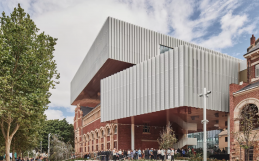At the end of the 57° edition of the Salone del Mobile in Milan, the international event of the world design and decor, let’s examine the related data. With over 430 thousand visitors in six days, coming from 188 Countries, with an increase of 17% compared to the edition of 2016, which proposed the same biennial exhibitions dedicated to the kitchen and the bathroom sectors, and an increase of 26% compared to 2017, the success went beyond all expectations.
But if the data of the event are important, so are those relating to the Design Week and Fuori Salone which recorded a workforce of 23 thousand companies and 150 thousand employees, confirming the mix of fashion and design as one of the economic engines of the Milan area.
According to the data provided by the Chamber of Commerce of Milan, Monza Brianza and Lodi, among the industries that have benefited from this week of design 50% regard accommodation and catering, 25% shopping and 25% services. The first beneficiaries are the companies that operate in the accommodation and catering sector with 1000 hotels and accommodations and more than 5000 restaurants and 5000 bar.
Numbers are important also for services, which represent approximately 23% of the total ancillary market with about 5000 enterprises, over 70% active in transport. In the shopping sector, which employs 27% of the companies of the city ancillary market, the clothing branch stands out, with almost half the sales, but also tobacco (10%) newsagents (8,5%) and jewellers (8%) represent an important quota.
All these data show that Milan have achieved significant levels of growth taking into account that the city employs 147.000 workers (6% the Country total of about 2.6 million) and generates about 20% of annual national turnover equal to about 20 billion of the 100 billion euro at national level.
Salone del Mobile: eccezionale crescita della manifestazione fieristica e dell’indotto milanese
Archiviata la 57° edizione del Salone del Mobile di Milano, l’appuntamento internazionale del mondo del design e dell’arredo, si fanno le prime somme. Con oltre 430 mila presenze in sei giorni, provenienti da 188 Paesi, con un incremento del 17% rispetto all’ edizione 2016 che proponeva le medesime biennali dedicate alla cucina e al bagno, e del 26% rispetto a quella del 2017, il successo è andato oltre ogni più rosea previsione della vigilia.
Ma se i dati della manifestazione sono importanti, altrettanto lo sono quelli riguardanti il Design Week e il Fuori Salone che hanno fatto registrare un indotto di 23 mila imprese e 150 mila addetti confermando come il binomio moda-design si confermi il motore economico del capoluogo Lombardo.
Secondo i dati forniti dalla Camera di Commercio di Milano Monza Brianza e Lodi, tra le aziende dell’indotto che hanno beneficiato di questa settimana all’insegna del design metà operano nell’alloggio e nella ristorazione, un quarto nello shopping e un quarto nei servizi collegati. I primi beneficiari sono le aziende che operano nell’alloggio e della ristorazione tra cui mille tra alberghi e alloggi e oltre 5 mila ristoranti e 5 mila bar.
Infine numeri importanti anche per i servizi, che rappresentano circa il 23 % del totale indotto con circa 5 mila imprese di cui oltre il 70% attive nei trasporti. Nello shopping che impiega il 27% delle imprese dell’indotto cittadino spiccano l’abbigliamento con quasi la metà delle vendite del comparto, ma anche i tabacchi (10%) le edicole (l’8,5%) e le gioiellerie (8%).
Tutto questo in un contesto italiano dove Milano registra sul totale nazionale una quota pari al 6% di addetti con 147 mila unità, su 2,6 milioni nel Paese e genera circa il 20% del giro d’affari annuale nazionale pari a circa 20 miliardi di euro su oltre 100 miliardi a livello nazionale.





